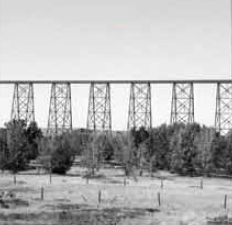Anyone who has ever driven through, flown over or lived more than six hours in Lethbridge has either seen or heard about the railroad bridge spanning the Oldman River Valley. And while debate still occurs on just what world record(s) it holds, two facts are indisputable: the High Level Bridge is an engineering and construction marvel and it turns 100 years old this year.
heard about the railroad bridge spanning the Oldman River Valley. And while debate still occurs on just what world record(s) it holds, two facts are indisputable: the High Level Bridge is an engineering and construction marvel and it turns 100 years old this year.
Bill Smienk, an instructor in Lethbridge College’s engineering design and drafting technology program, says the bridge still holds the record as the longest railroad trestle bridge for its height (or perhaps it’s the highest bridge for its length). Regardless, there is some superlative to which we hold bragging rights. And we can point with pride at the 33 towers that transport more than 11,000 tonnes across 1.6 kilometres at a maximum height of 95.7 metres above the valley below.
So intrusive a landmark is the bridge that some visitors believe the city’s second syllable must bear some reference to it. They forget Lethbridge, in fact named for an English financier who never came here, had been an official city for 24 years when the bridge opened in 1909. Since then, the bridge has been a symbol of economic might, a railroad romanticist’s daydream, a site of youthful derring-do and a tragic stepping off point for the despondent.
The bridge was originally built, at a cost of $1.3 million, to shorten the rail distance between Lethbridge and Fort Macleod. As the late Lethbridge historian Alex Johnston noted in one of his papers: “Up to this point, the bridges constructed in the west had been of wooden timbers. The design chosen for this bridge was a steel viaduct consisting of 44 plate girder spans 67 feet, 1 inch long, 22 plate girder spans 98 feet, 10 inches long, and one riveted deck lattice truss span 167 feet long.”
The designers knew all about the winds of southern Alberta and the weight the structure would have to support. They designed it well beyond the specifications of the day, and the 100-plus steelworkers who pieced it together on its massive concrete bases did so with unerring accuracy and competence. When the bridge was surveyed some 25 years ago, it was discovered that, through the previous seven decades, it had sunk – something less than three centimetres.
Smienk, a model-railroad enthusiast, agrees “although the steam locomotives of the early 1900s were actually heavier than today’s modern diesel engines, what has increased in weight is the cargo.
“They’re pulling longer, heavier rolling stock today,” says Smienk. “That’s one thing they might not have anticipated in 1909.”
Trestle bridges are most commonly used on railroads, primarily over rivers and across floodplains. Our bridge has experienced more than one flood; the detritus still caught in its lower limbs is the result of the last one in 1995.
The structure was designed in Montreal by the CPR’s bridge department; the steel was brought west from Walkerville, Ont. in 645 rail cars. Site preparation and footing work was begun in 1907; the steelwork began in August 1908 and was completed in June 1909; riveting was finished two months later. Erection “travelers” were specially built for the project, to venture out on the bridge as it proceeded from the eastern side and lower girders into place below.
The CPR’s goal of shortening its trip west from Lethbridge required a second Oldman River crossing at Monarch. That structure, visible from Highway 3, is about one-third the length of the High Level Bridge, and about half its height. The two structures fulfilled the CPR’s goal, eliminating additional bridges and easing the grade over which the tracks were laid. While it still serves the transportation role for which it was built, the High Level Bridge has become more than a mere engineering feat. It is one of the best-known and most-photographed sights in southern Alberta, a touchstone of our heritage.


